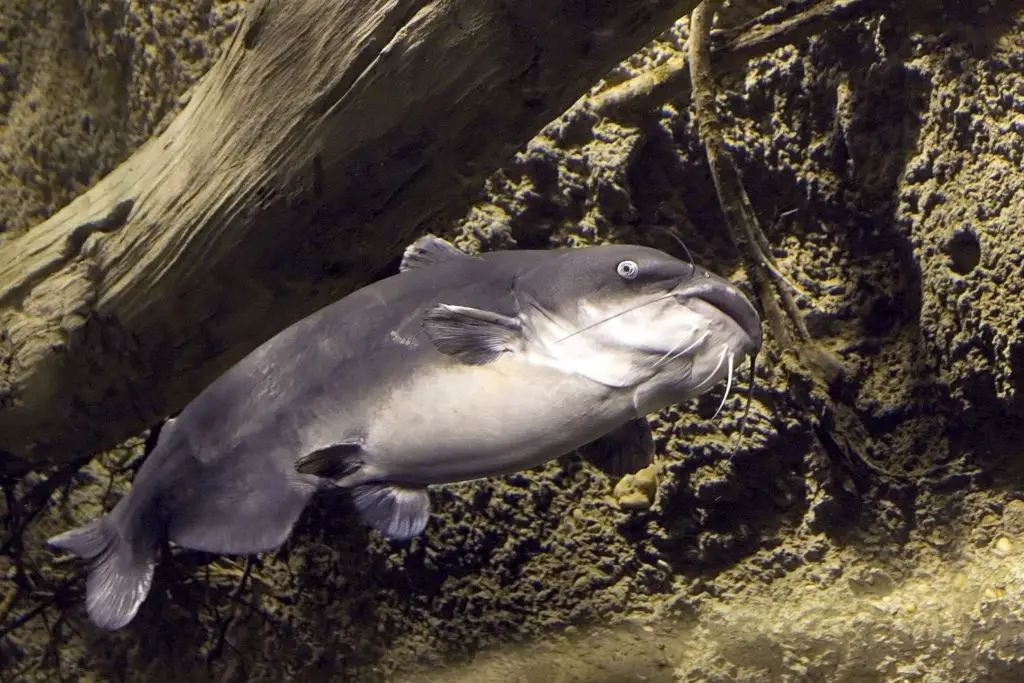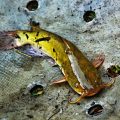Blue catfish, scientifically known as Ictalurus furcatus, is the largest species of North American catfish. This fish belongs to the family Ictaluridae and the order Siluriformes. This record-breaking fish is migratory, which means they move seasonally in response to changes in water temperature. They can live up to as long as 20 years and are spread over a large area.

Where do Blue Catfish live?
Blue catfish prefer to stay in large rivers that have deep channels characterized by swift, speedy currents. They also have a preference for sandy bottoms, as they are bottom dwellers and stay near it most of the time.
Originally, blue catfish were native to the Mississippi river drainage. This includes the Missouri, Ohio, Tennessee, and Arkansas Rivers. They are also native to the Des Moines River in South Central Iowa and the Rio Grande. Another set of the population were natives to the stream along the southern Gulf Coast to Belize and Guatemala.
Over time, the blue catfish were introduced to some more places, and their habitat expanded further. They have been introduced to a number of reservoirs and rivers all across the US. Some of the notable ones are the Santee Cooper lakes of Lake Marion and Lake Moultrie in South Carolina, the James River in Virginia, Powerton Lake in Pekin, Illinois, and Lake Springfield in Springfield, Illinois. Blue catfish have also been spotted in some lakes in Florida, but the population there is still scanty.
Blue catfish have also invaded some areas and are considered invasive pests. The most common example is the Chesapeake Bay. This invasion mainly happened because blue catfish have the capability to tolerate and adapt to brackish waters, so with their size and influence, they can colonize along inland waterways of coastal regions.
What does a Blue Catfish look like?
Like other catfish, blue catfish have smooth skin that lacks scales, and around their mouth are the whisker-like structures called barbels. Four pairs of barbels are usually seen around their mouths. This species of catfish has a deeply forked tail. Their dorsal fin is flat, while their anal fin is straight edged.
The back of the blue catfish steeply slopes straight from the dorsal fin to forward, giving its head and frontal part of the body a distinctive wedge-shaped appearance. They usually display a silvery blue coloration, and their belly is white.
Blue catfish are often mistaken for channel catfish and vice versa because both have the forked tail and look similar in other aspects as well. Certain physical characteristics can distinguish them. For example, blue catfish have 30 to 35 rays in their anal fin, but channel catfish have a smaller number of the same. The base of the anal fin is also relatively longer than that of a channel catfish.
Moreover, blue catfish do not show any dark spots on their backs and sides, but channel catfish do. Another distinguishable feature is that channel catfish have rounded anal fins that taper toward the back in a flat line.
How much does Blue Catfish grow?
Blue catfish typically grow up to around 2 feet on average, but some can grow up to as much as 5 feet long and weigh up to more than 100 pounds. They are one of the largest species of catfish ever to exist. Different species of catfish grow at different rates normally.
On June 18, 2011, a man named Nick Anderson from Greenville, North Carolina, caught a 143-lb blue catfish from the John Kerr Reservoir on the Virginia-North Carolina border. This blue catfish was acknowledged and certified as the state’s largest fish ever on June 22, 2011, by the Virginia Department of Game and Inland Fisheries. This fish had a length of 57 inches (145 cm), while the girth was around 47 inches (120 cm).
What do Blue Catfish Eat?
Due to their large size, you can definitely guess that blue catfish are predators. These opportunistic predators can eat any species of fish that they can catch, which includes several fish that are smaller than them in size. Some examples include crawfish, freshwater mussels, frogs, fingernail clams, immature aquatic insects, and so on. An interesting fact is that blue catfish are one of the only species of fish in the Mississippi river basin able to eat adult Asian carp.
As mentioned earlier, blue catfish are bottom dwellers. They are often seen feeding beneath the marauding schools of striped bass in the open water of reservoirs. Sometimes they can be seen feeding on wounded baitfish as well. This proves that if they can, they avoid actively hunting down the prey and would settle for prey that is already wounded or dead to make things easier for them.
Like other catfish, blue catfish also search for and detect food with the help of their barbels, which contain sensory nerves. Though they mostly feed on the bottom, they sometimes also hunt for food in the midwater. Smaller catfish, as in those within the length of only 4 to 5 inches, don’t manage to eat other fish but rather live and grow on small invertebrates. However, after growing up to around 8 to 13 inches, their diet is mostly filled with fish and larger invertebrates.
Is Blue Catfish Edible?
Blue catfish are edible and deliciously so. Their taste can be compared with that of striped bass, which is another Bay favorite. If you’re worried that they will taste muddy because they are bottom feeders, then know that adult blue cats don’t typically feed from the bottom, so they won’t taste like that. Plenty of amazing recipes are available for cooking blue catfish, and many hotels have this as an expensive but popular dinner item.
Not only is blue catfish edible, but it also has good nutritional value. A 4-ounce serving of this fish includes 19 grams of protein and lots of healthy Omega-3 fatty acids. To make it better, the fish is quite low in fat, containing only 90 calories and 1.5 grams of fat.












Pingback: Are Catfish Keto-Friendly? | Reel Fishing Guru
Pingback: Differences Between Catfish and Dogfish | Reel Fishing Guru
Pingback: Do Catfish Eat Bass? | Reel Fishing Guru
Pingback: Do Catfish Eat Crappie? | Reel Fishing Guru
Pingback: What Is the Difference Between Catfish and Mahi Mahi? | Reel Fishing Guru
Pingback: What is the Difference Between Catfish and Hardhead? Identifying Key Variations | Reel Fishing Guru